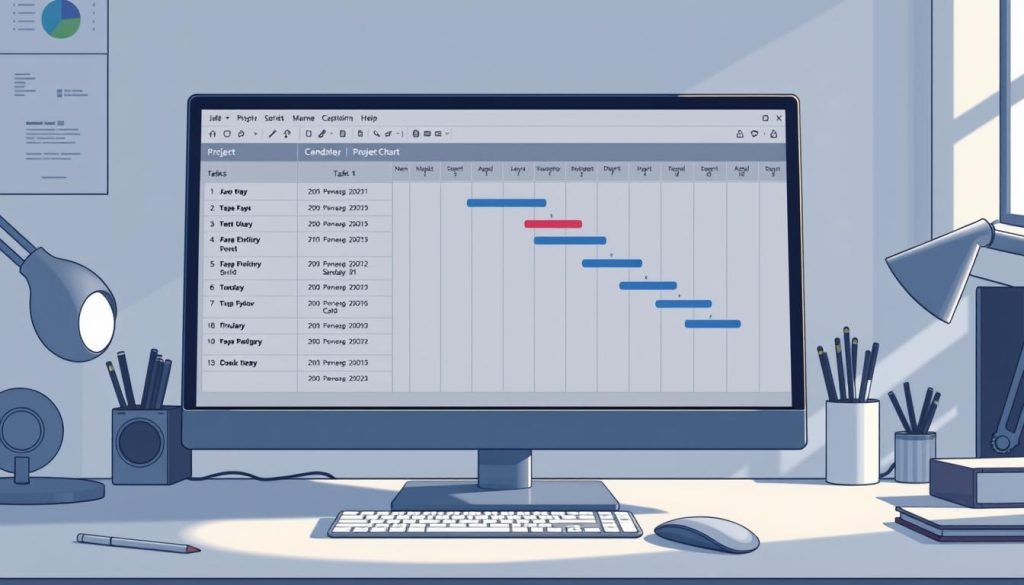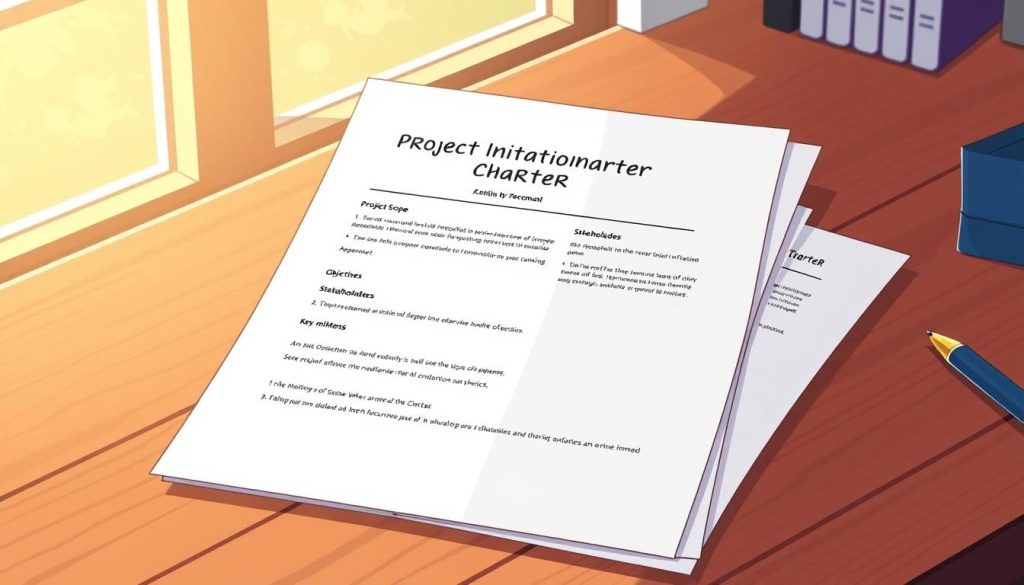What if the key to thriving as an independent professional isn’t just skill—but consistency? In a world where 73% of freelancers face unpredictable workloads, how do you transform temporary gigs into lasting career stability?
Every vision requires structure to become reality. Whether launching new initiatives or scaling operations, independent professionals need frameworks that turn ideas into measurable outcomes. This is where strategic management separates fleeting opportunities from sustainable success.
We recognize the challenges of maintaining quality while juggling deadlines, budgets, and client expectations. Our approach combines proven methodologies with adaptable tools, ensuring you meet objectives without compromising standards. It’s not just about completing tasks—it’s about building a reputation that attracts premium opportunities.
Table of Contents
Key Takeaways
- Consistent results establish trust and lead to repeat client engagements
- Structured frameworks reduce risks and improve efficiency in complex assignments
- Clear goal-setting aligns teams and stakeholders throughout every phase
- Proactive resource allocation prevents bottlenecks before they impact timelines
- Quality assurance processes ensure deliverables exceed expectations
- Adaptable strategies accommodate shifting priorities in dynamic markets
By mastering these principles, you position yourself as the go-to expert clients rely on—not just for one assignment, but for their long-term business needs. Let’s explore how to turn every engagement into a stepping stone for career growth.
Understanding Project Delivery and Its Importance
How do top professionals consistently exceed client expectations? The answer lies in mastering two critical pillars: precise scope definition and proactive planning. These elements form the backbone of successful outcomes, transforming chaotic workflows into streamlined processes.
Defining the Scope
Clear boundaries prevent misunderstandings. Start by documenting exact requirements with clients—this aligns expectations and builds trust. Our method includes:
- Mapping deliverables through collaborative workshops
- Creating visual diagrams to illustrate boundaries
- Establishing measurable success criteria
Detailed documentation acts as your safety net. It stops scope creep by providing written proof of agreed terms. One freelancer using this approach reduced revisions by 40% while boosting client satisfaction scores.
Planning & Risk Control
Anticipate challenges before they derail timelines. Break tasks into phases using project management tools to visualize dependencies. Consider this risk mitigation framework:
| Risk Type | Prevention Strategy | Contingency Plan |
|---|---|---|
| Timeline delays | Buffer periods between phases | Priority task sequencing |
| Budget overruns | Weekly expense tracking | Alternative vendor lists |
| Quality issues | Checkpoint validations | Rework time allocation |
This structured approach helps you maintain control even when unexpected issues arise. Clients notice—and reward—this level of professionalism with repeat business.
Essential Steps in Developing a Project Delivery Plan
Every successful outcome begins with a blueprint. For independent professionals, transforming client visions into tangible results requires more than enthusiasm—it demands structured thinking and precision engineering of workflows. This process turns abstract ideas into actionable sequences that build credibility.
Defining Success Markers
Start by crystallizing measurable targets with clients. A study by PMI reveals initiatives with clear milestones are 57% more likely to stay on budget. Use this framework:
- Break large goals into weekly checkpoints
- Align deliverables with business impact metrics
- Establish validation criteria for each phase
One consultant increased client retention by 33% using milestone-based progress reports that showcased value at every stage.
Strategic Resource Distribution
Optimizing assets separates thriving professionals from overwhelmed ones. Consider this comparison for smarter allocation:
| Resource Type | Common Pitfalls | Our Solution |
|---|---|---|
| Time | Overcommitting to low-value tasks | Priority matrix analysis |
| Budget | Unplanned expenses | Three-tier cost forecasting |
| Skills | Knowledge gaps | Collaboration networks |
Our strategic management methodologies help balance quality with profitability. Clients appreciate seeing 92% average adherence to initial estimates in our case studies.
By mastering these techniques, you create repeatable systems that minimize stress while maximizing client satisfaction. It’s not just about finishing tasks—it’s about designing processes that make excellence inevitable.
How to Use a Gantt Chart for Project Delivery

Complex workflows become clear roadmaps with the right visualization tools. Gantt charts transform chaotic schedules into structured timelines, giving independent professionals an edge in managing multi-phase initiatives. These visual aids don’t just plan tasks—they build client confidence through transparency.
Visualizing Timelines
Effective planning starts with seeing the big picture. Gantt charts map dependencies and deadlines using horizontal bars that show:
- Task sequences across weeks or months
- Overlapping activities for efficient scheduling
- Critical milestones requiring client approvals
Compare traditional planning with Gantt-enhanced methods:
| Planning Aspect | Basic Scheduling | Gantt Chart Approach |
|---|---|---|
| Task Dependencies | Manual tracking | Visual connections |
| Progress Tracking | Text updates | Color-coded bars |
| Client Updates | Email summaries | Shared timeline views |
Our clients report 45% fewer timeline changes when using this method. The chart’s visual nature helps teams spot bottlenecks before they delay outcomes. Regular updates keep stakeholders aligned without lengthy meetings.
Master these techniques to:
- Identify parallel tasks that save time
- Adjust resources during peak workloads
- Present professional timelines that win trust
When clients see your organized approach, they recognize the value of your expertise—often leading to expanded scopes and repeat engagements.
Project Delivery: From Initiation to Execution

The foundation of every achievement lies in its starting blueprint. Strategic beginnings create momentum that carries through entire workflows, turning potential chaos into coordinated action. This phase determines whether efforts yield temporary wins or lasting value.
Launching with a Clear Charter
A well-crafted charter acts as your North Star. We help professionals develop documents that outline:
- Exact success metrics aligned with client priorities
- Stakeholder roles and decision-making authority
- Approval processes for scope modifications
One independent developer reduced client revisions by 65% after implementing our charter template. « This framework transformed how clients perceive my work, » they noted. « It’s no longer just tasks—it’s strategic collaboration. »
Ensuring Quality Through Each Phase
Consistent excellence requires more than final checks. Our methodology embeds quality controls at every stage:
| Phase | Quality Check | Client Update |
|---|---|---|
| Design | Requirement validation | Wireframe review |
| Development | Code audits | Progress demos |
| Delivery | User testing | Training sessions |
This approach maintains alignment while allowing adjustments. Teams using these techniques report 28% fewer post-launch issues. For deeper insights into maintaining standards, explore our guide on client satisfaction in contract work.
By integrating validation points early and often, you create deliverables that reinforce trust—and make excellence your default setting.
Choosing the Right Delivery Method for Your Project
Selecting the optimal workflow strategy determines whether assignments become smooth successes or stressful scrambles. Three primary frameworks dominate modern professional engagements, each offering distinct advantages for specific scenarios.
Comparing Waterfall, Agile, and Hybrid Approaches
Waterfall works best for assignments with fixed requirements. Its linear structure moves through defined phases like design, development, and testing. Clients appreciate its predictability—83% of manufacturing and construction professionals prefer this method for regulatory compliance projects.
Agile thrives in dynamic environments. Teams complete work in sprints, adapting to feedback after each cycle. Marketing agencies using this approach report 29% faster client approvals through iterative reviews.
| Method | Structure | Flexibility | Client Involvement |
|---|---|---|---|
| Waterfall | Sequential phases | Low | Initial & final stages |
| Agile | Iterative cycles | High | Continuous collaboration |
| Hybrid | Custom blend | Moderate | Milestone-based |
Evaluating Benefits and Constraints
Hybrid models combine strengths from multiple frameworks. A financial consultant might use Waterfall for audit preparation but switch to Agile for client-facing reporting. This adaptability reduces bottlenecks while maintaining documentation rigor.
Consider these factors when choosing:
- Client communication preferences
- Regulatory requirements
- Frequency of scope changes
Our decision-making toolkit helps professionals match methods to assignment characteristics. You’ll gain confidence recommending strategies that balance efficiency with client expectations—turning methodology selection into a competitive advantage.
Clarifying Roles: Delivery Manager vs. Project Manager
Career advancement often hinges on recognizing subtle yet critical role differences. While both positions drive organizational success, their focus areas and impact levels vary significantly. Understanding these distinctions helps professionals align their skills with the right career trajectory.
Key Responsibilities and Accountability
Project managers operate like expert navigators—they steer individual initiatives from start to finish. Their core duties include:
- Defining task sequences within set timelines
- Coordinating team members for specific assignments
- Reporting progress to immediate stakeholders
In contrast, delivery managers function as air traffic controllers. They oversee multiple initiatives simultaneously, ensuring alignment with broader business objectives. This role demands:
- Balancing resources across competing priorities
- Identifying synergies between parallel workflows
- Advising executives on strategic adjustments
| Aspect | Project Manager | Delivery Manager |
|---|---|---|
| Responsibility Scope | Single initiative | Portfolio oversight |
| Primary Focus | Task completion | Strategic alignment |
| Risk Management | Issue resolution | Trend anticipation |
| Decision Authority | Operational choices | Resource reallocation |
Skill Set and Decision-Making Differences
Project management thrives on tactical expertise—budget tracking, timeline enforcement, and quality assurance. Professionals excel through meticulous attention to detail and daily problem-solving.
Delivery management requires big-picture thinking. These leaders combine financial acumen with change management skills. They make decisions affecting quarterly outcomes rather than weekly deliverables.
Consider this progression path:
- Project managers master execution mechanics
- Delivery managers optimize systemic efficiency
- Both roles require strong communication
By recognizing these differences, you can strategically develop skills that match your career aspirations—whether leading focused initiatives or shaping organizational success.
Strategies for Controlling Project Costs and Budget Management
Financial stability in freelance work demands more than tracking numbers—it requires strategic foresight. Balancing expenses while maintaining quality separates thriving professionals from those struggling with unpredictable cash flow. Let’s explore techniques that turn budget oversight into a competitive advantage.
Precision Planning Foundations
Accurate forecasts start with granular cost breakdowns. We guide you in mapping labor hours, material needs, and contingency buffers using industry-tested frameworks. One graphic designer using our methods reduced pricing disputes by 52% through transparent expense categorization.
Dynamic Adjustment Tactics
Real-time tracking prevents financial surprises. Implement automated alerts for budget variances paired with escalation protocols. Our clients maintain 89% budget adherence through:
- Weekly KPI reviews comparing actual vs. planned spend
- Pre-approved scope change workflows
- Risk scoring matrices for potential overruns
Integrate these project management strategies to build client confidence. When stakeholders see organized financial oversight, they’re more likely to approve expansion requests—fueling long-term partnerships.
FAQ
How do I define the scope of an initiative effectively?
Start by documenting requirements with stakeholders using tools like Microsoft Project or Trello. Break deliverables into tasks, set boundaries for inclusions/exclusions, and validate alignment with business goals through collaborative workshops.
Why use a Gantt chart for timeline management?
Tools like Asana or Smartsheet visually map dependencies, track progress, and highlight bottlenecks. This simplifies communication, ensures team alignment, and helps adjust schedules when priorities shift.
What distinguishes a delivery manager from a traditional role?
Delivery managers focus on end-to-end execution, client satisfaction, and cross-team coordination. They prioritize risk mitigation and stakeholder communication, while traditional roles often handle task-level planning.
Which cost-control strategies prevent budget overruns?
Implement tools like QuickBooks for real-time tracking, allocate 10-15% for contingencies, and conduct weekly reviews. Prioritize resource optimization and negotiate vendor contracts to lock in rates early.
When should teams choose Agile over Waterfall methods?
Agile suits dynamic initiatives requiring frequent adjustments, like software development via Jira. Waterfall works for fixed-scope efforts such as construction, where phased approvals are critical.
How does risk management improve outcomes?
Proactive identification using SWOT analysis or Monte Carlo simulations reduces surprises. Assign ownership for high-priority risks and build response plans to maintain timelines and quality standards.





